On April 2, 2025, a key turning point in the global financial markets is set to occur. U.S. President Trump is expected to announce corresponding tariff measures in the White House Rose Garden at 3 PM on Wednesday (3 AM Beijing time the next day).
Due to concerns over the impending tariffs, U.S. stocks plummeted on March 28, with technology stocks leading the decline. The market capitalization of the seven major tech giants (including Apple, Microsoft, Amazon, etc.) evaporated by approximately $505 billion, and the Philadelphia Semiconductor Index fell by 2.95%. This marked the largest single-day drop since the U.S. stock market crash on March 10, indicating a severe adjustment at the end of the first quarter of 2025.
In the cryptocurrency market, Bitcoin dropped from $84,000 on the afternoon of March 29 to $81,644 within 8 hours, a decline of over 3%. It then rebounded to $83,536 at 6 PM on March 30 but failed to maintain the upward momentum, falling to $81,565 by 6 AM on March 31. The total market capitalization of cryptocurrencies fell from a peak of $3.9 trillion to $2.9 trillion, a drop of 25%, while trading volume shrank from $126 billion after the November 5 election to $35 billion, a contraction of about 70%.
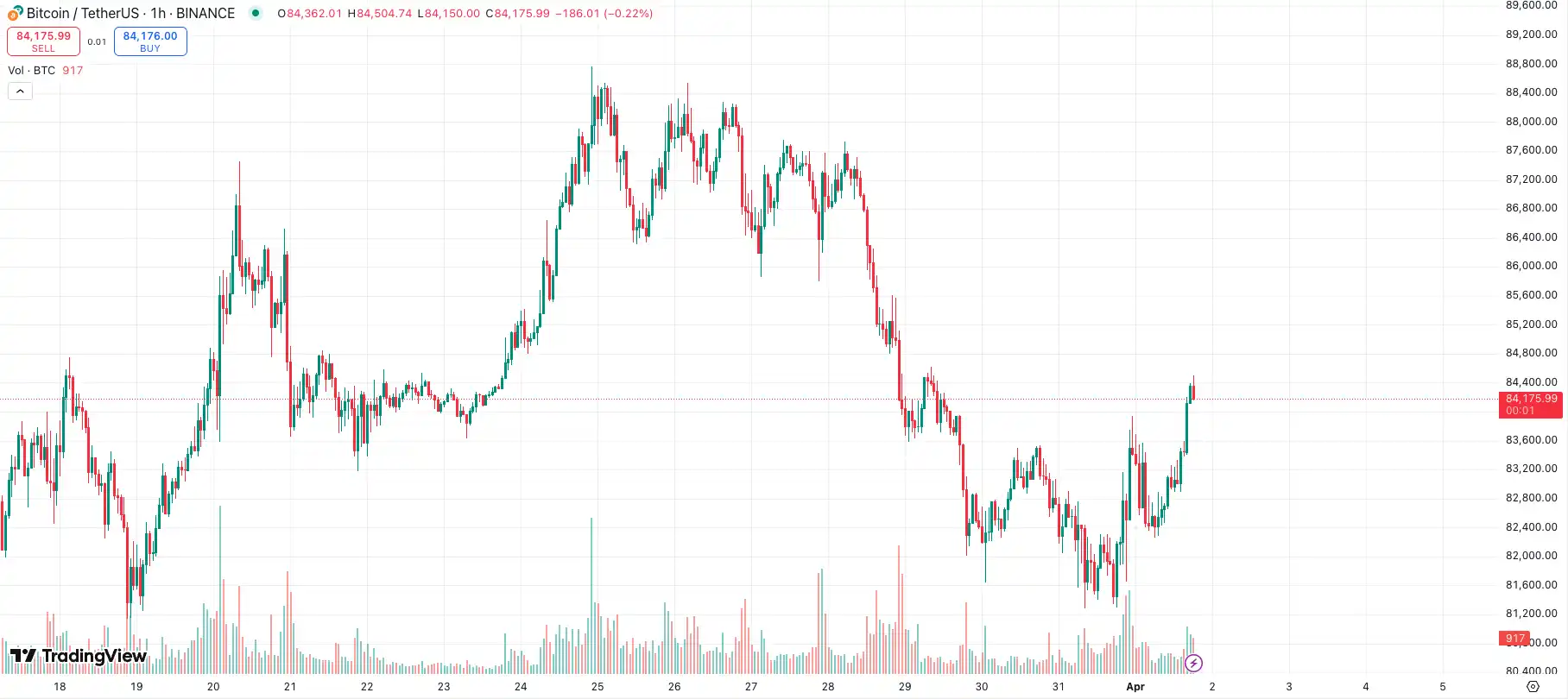
In both public appearances and private discussions, Trump has claimed that tariffs are a "win-win" policy, capable of bringing manufacturing jobs back to the U.S. while generating trillions of dollars in new revenue for the federal government. He also stated that allowing his advisors to dissuade him from implementing higher tariffs during his first term was a mistake; he now believes that imposing a simple, uniform tax rate on most imported goods will help avoid exemptions that weaken the effectiveness of tariffs.
Trump has publicly praised the benefits of import taxes, even calling "tariff" the "most beautiful word" in the dictionary, and stated that 19th-century tariff policies led to the economic peak in U.S. history. Some allies have even proposed designating April 2, the anniversary of the tariffs, as a federal holiday. Trump's chief strategist during his first term, Steve Bannon, suggested that instead of celebrating Trump's birthday, a "Liberation Day" should be established as a national holiday to honor the return of jobs, skills, and trade to the U.S. and its workers.
The most likely option to be adopted is a proposal publicly put forward this month by Treasury Secretary Scott Bessenet: imposing tariffs on 15% of countries deemed the worst trade partners by the White House, which account for nearly 90% of U.S. imports. Additionally, Trump has pushed for other tariff policies that cover all countries but target specific industries. On Wednesday, he imposed a 25% tariff on all auto imports and hinted at similar measures for pharmaceuticals, timber, and other industries.
However, the market's greatest concern remains the ongoing uncertainty brought about by the repeated adjustments to policy. This "dull knife cutting flesh" risk is forcing traders to reassess their investment logic for the second quarter. BlockBeast has compiled analyses from analysts across multiple dimensions, including macro games, technical patterns, and policy variables, combining long and short positioning signals and historical structural replication paths to reveal potential trading opportunities and traps in the eye of the storm.
Macroeconomic Analysis
@OwenJin12
1. Is VAT included (if yes, it's bearish; if no, it's bullish)
If the reciprocal tariffs consider VAT as previously mentioned, then the reciprocal tax rate will be higher than expected.
2. Are there tariff exemptions for Mexico and Canada (if yes, it's bullish; if no, it's bearish)
As previously stated, the tariff system proposed by Lutnik is an extension of domestic policy, hoping to promote North American internal circulation to facilitate negotiations. Mexico and Canada are the U.S.'s top two trading partners, and if exemptions can be granted, the stagflation pressure will be somewhat reduced.
3. How does the dollar index respond?
Tariffs trigger supply-side inflation, and supply-side inflation will interact with the strength of the dollar—if the DXY rebounds from a low, it will hedge some of the tariff effects; if the DXY continues to decline, future inflation pressure will increase.
The strength of the dollar amplifies supply-side inflation; if the dollar appreciates, stagflation pressure will relatively weaken.
4. Changes in expectations
The macro environment in Q1 is not bad, with liquidity not tight, QT slowing down, and both the 10-year yield and DXY declining. However, since February, accompanied by changes in policy expectations, the crypto market has experienced multiple "Black Mondays" during U.S. stock futures opening times, from deep-seeking valuation squeezes to sudden tariff countermeasures against Mexico and Canada, and then to recession expectation trading. Overall, there are three changes in expectations:
① "Reinflation expectations" brought about by tariffs
② "Recession expectations" due to soft economic data and the Fed's wait-and-see stance leading to stagflation
③ "Adjustment expectations" due to overvaluation in the post-pandemic era
In trading, I believe that if these three expectations cannot be reversed, it will be difficult to reverse the previously priced range of $78,000 to $91,000. So far, I have not seen any concessions on tariffs, so if they exceed expectations, I will look for divergences to take counter positions.
Bullish opportunities in 2025 may arise from the impact of tariffs being realized + expectations reversing due to tax reduction proposals (which have not yet emerged, so we wait patiently).
@Phyrex_Ni
Actually, the risk aversion sentiment for Bitcoin has improved significantly by now. After the U.S. stock index futures opened this morning, they all fell, mainly because April 2 is approaching, and many investors are choosing to hedge against the uncertainty of tariffs. Currently, the Nasdaq futures are down over 1.2%, and the S&P 500 futures are down 0.75%. Investors in the Asian market are taking precautions.
Now the market is waiting for the final implementation of Trump's tariffs, and the biggest concern is not the one-time tariffs but Trump's repeated adjustments to tariffs, which may make the market feel at greater risk.
However, it is important to note that an increase in difficulty does not necessarily mean a decline, as it is still event-driven. Trump may reverse course again at any time, which adds to the difficulty. The second quarter may be more challenging than the first quarter, with inflation, tariffs, the Fed maintaining interest rates, and Japan's interest rate hikes potentially impacting risk markets. The tariffs in April will be the main reason for the increased difficulty in risk markets, and it cannot be simply commented on as good or bad; it is more about "game theory."
@CryptoPainter_X
This is the ASR-VC daily channel before the last bull market turned bearish, which indeed has some similarities to the current situation;
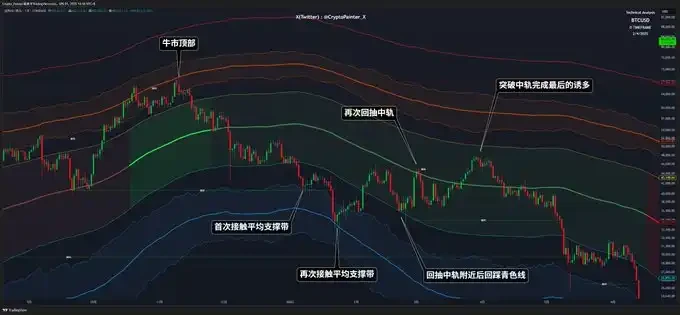
I have drawn potential paths for similar structural replication on the chart. The general idea is that if this is the final stage of the bull-to-bear transition, we still need to wait for one last bullish trap.
Again, I do not recommend simply sticking to the boat; inductive reasoning does not work well in the market. However, understanding the previous structural trends and their reasons, and applying the same logic to the current situation is still valid.
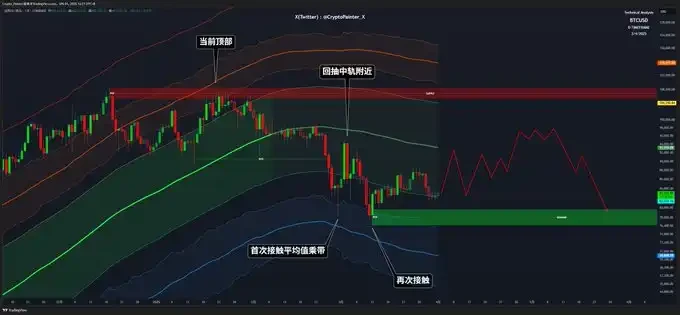
@qinbafrank
In my personal view, various parties have effectively subdivided the tariffs into multiple scenarios, with the core still revolving around the previously discussed moderate version and the most hardline version. Other scenarios oscillate between these two versions. What needs to be considered regarding market performance is:
1) If it is the most hardline version, will the days following the 2nd be the peak of uncertainty for the foreseeable future? Because the most hardline version will definitely trigger the most pessimistic expectations in the market and will also cause a huge shock. After that, countries will negotiate with the U.S. separately, as the worst-case scenario has already emerged, and any positive developments in negotiations will boost market confidence.
2) If it is the moderate version, the market should perform well on that day, and if it is not as bad as everyone thinks, confidence will naturally rise. However, the subsequent negotiations will definitely be back and forth, so the market will likely surge on the 2nd and 3rd, then experience fluctuations, retreating one step or two, and the back-and-forth grinding will take a long time.
Technical Analysis
@YSI_crypto
Currently, the 1H chart is still in a downward channel, but there is a short-term structural reversal within the channel. Coupled with indicators crossing above, we will first look towards the $83,600 area to observe if there are continued resistance.
The next opportunity to enter a long position has been marked on the chart, which is a "pullback after a breakout" strategy.
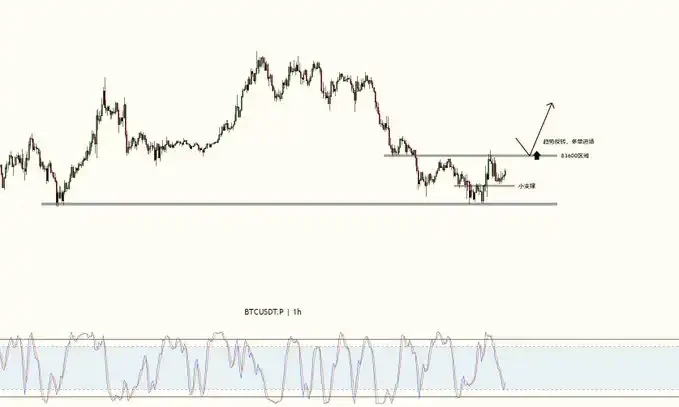
@CryptosLaowai
BTC continues its downward trend in the short term. A false breakout at the $83,000 resistance level appeared on the 4-hour chart, and it has now fallen back. In the small cycle, it is expected to drop to $79,500 to form the first bottom, then rebound after the tariffs are implemented on Wednesday, leading everyone to think it should rise, before forming a bottom within a bottom at $78,000. The trend is referenced in the chart below.
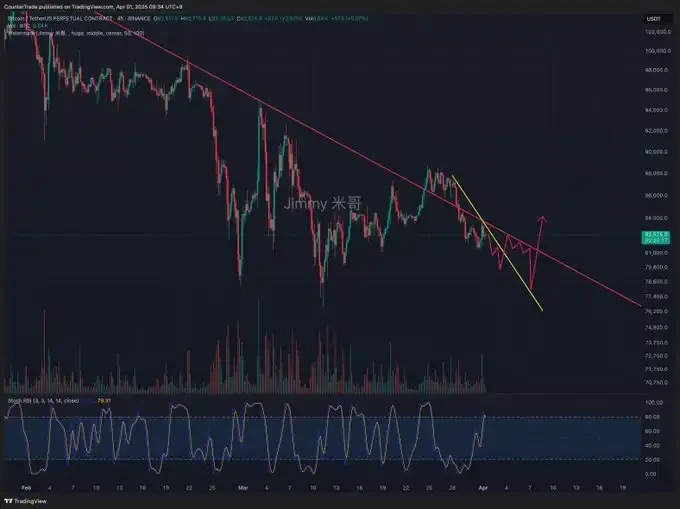
@GuilinChen
Channels are a very weak structure; the existence of a channel is meant to be broken, this is my experience;
If we consider the drop from $109,000 to $76,000 as the first phase of the entire decline, I believe the rebound from $76,000 to date has not completed, as shown in the chart:
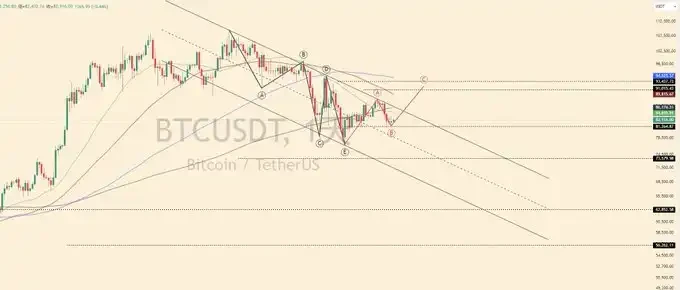
- Continuous declines have created a demand for the technical indicators to be repaired.
Subjective speculation:
Currently, the speculation revolves around the inflation rise brought by tariffs and the expectation of an impending recession, rather than an actual recession that is already occurring. As I mentioned in a previous post, we need to observe the price performance before the shoe drops on April 2. When sentiment and price reach a critical point, look for opportunities to take counter positions.
Fact 1: We are currently undergoing a long-short transition, with daily moving averages turning downward. MA30, MA60, and MA120 are forming a bearish arrangement, and from both a technical and macro perspective, there is no possibility of a reversal into a bull market. Fact 2: If this adjustment is a correction of the large-scale rise from 15,476 to 109,000, then this adjustment level will be significant, and large adjustments will certainly involve back-and-forth movements rather than a continuous decline. Therefore, a lack of reversal does not mean there won't be a rebound.
Selling hypothesis cycle: In a situation where there is insufficient capital in the market, a small amount of funds can control the market trend, which lowers the cost of controlling funds for the main players. The back-and-forth movements help raise the average selling price for the main funds, while altcoins can just lie flat and wait to die, selling weakly. However, high-quality assets like Bitcoin have the confidence to sell at high positions.
@biupa
There are two possible paths for the upcoming movements.
The first is to test below 81,200 again, causing the indicators to fully resonate, which can confirm a major bottom. The second is to start rebounding from here, with 81,200 acting as a bottom (although it may not fully resonate strongly, the two resonances still indicate a bottoming phenomenon).
Considering the news, I believe that after the tariff conclusion appears tomorrow, April 2, we can basically determine the direction (final drop vs. bottom rebound). Given that this is the first time since March 11 that the Acc indicator has turned green, it is not suitable to be completely out of the market here.
免责声明:本文章仅代表作者个人观点,不代表本平台的立场和观点。本文章仅供信息分享,不构成对任何人的任何投资建议。用户与作者之间的任何争议,与本平台无关。如网页中刊载的文章或图片涉及侵权,请提供相关的权利证明和身份证明发送邮件到support@aicoin.com,本平台相关工作人员将会进行核查。




